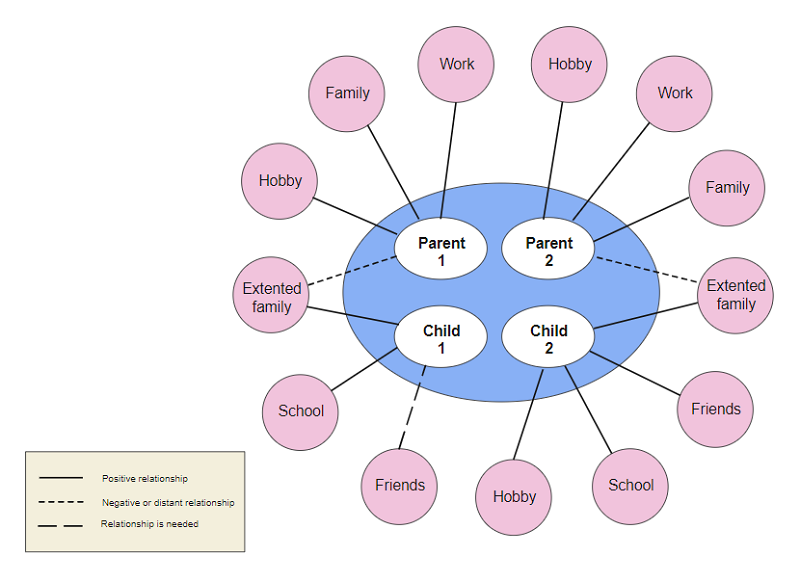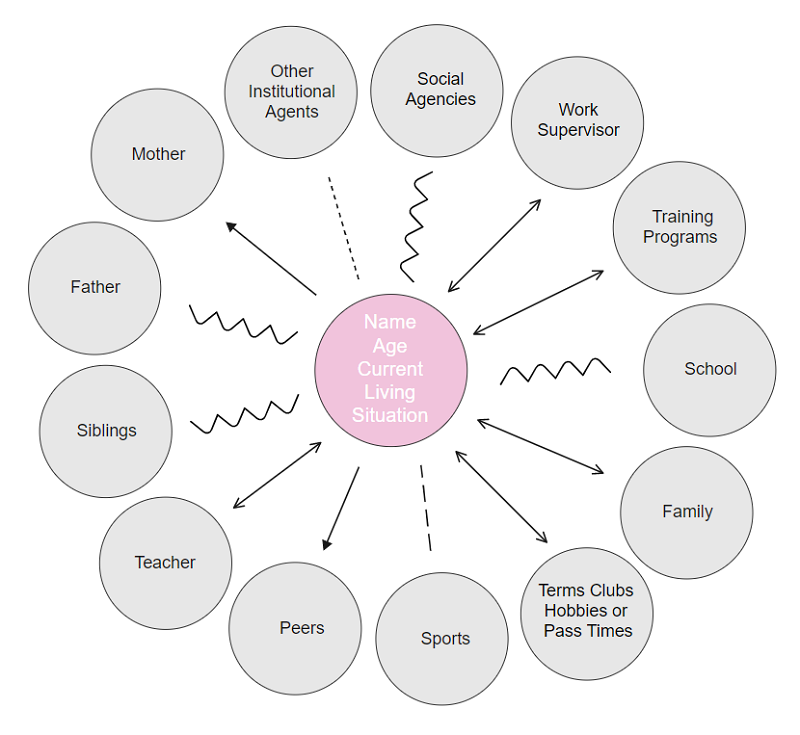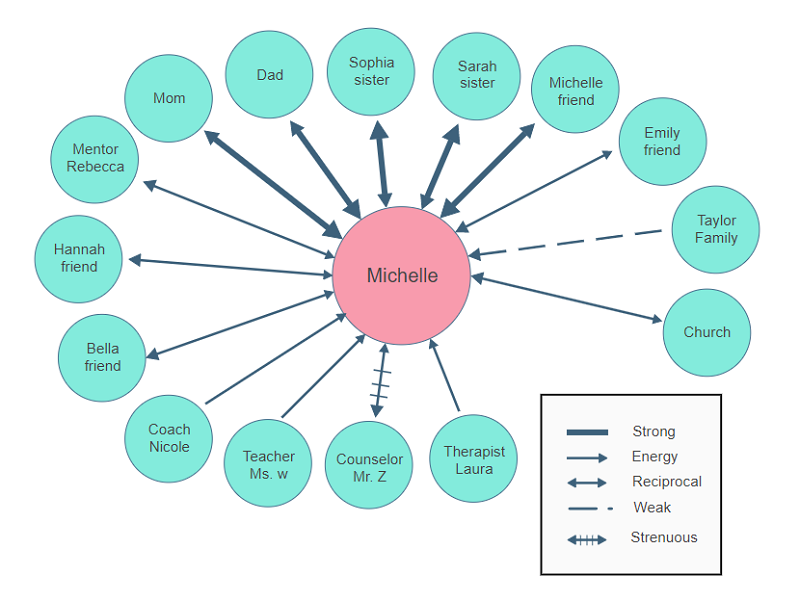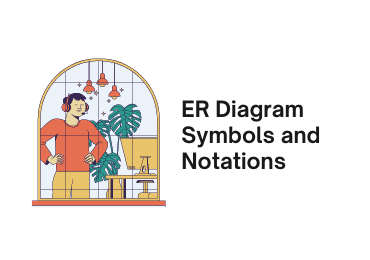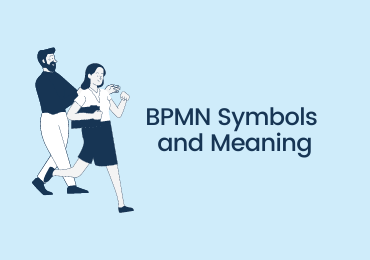What is an Ecomap?
1. What is an Ecomap?
Ecomaps are one type of visual tool, which provides useful information about an individual and his or her connections to the external world. These visual tools are usually filled by a counselor or medical personnel to help understand the individual in question better. Hartman developed this system for the first time in 1975 so that depicting the ecological system, which encompasses the society, becomes possible.
These visual representations are quite like genograms. However, while genograms show the make-up of an individual’s family or surrounding, ecomaps show who are in the individual’s network, the connection of the individual with them, and so many more. As a whole, ecomaps are useful for understanding the relationships in a family, society, community, and others.
What Should Be Included in an Ecomap
An ecomap usually centers the individual in question, which can be a young member of the family or any other member of the society. Various shapes are used in an ecomap to connect other members of the ecomap with the central one. However, based on the type, an ecomap usually includes some common connections. As ecomaps are commonly used for family connections, here are some connections that are commonly included in a family ecomap.
- Schooling
- Friends
- Extended family members
- Religious connection, i.e., place of worship
- Social services
- Medical health services
- Community engagement
- Sports team
- Social clubs
- Place of work
- Hobbies
These are some common ones to include in a family ecomap. However, different ecomap templates include different elements.
2. Ecomap Symbols
Ecomaps include different types of symbols, most of which are lines, to connect the centered individual with the rest. In terms of relationships, the lines and their meaning are as follows.
Thicker lines: These lines are often darker if not thicker. In an ecomap, they denote stronger relationships between the two ends of the line. In some cases, two lines are drawn to denote the same, strong and positive, connection.
Curvy lines: These lines are often red in color when not curvy or both. In a family ecomap or any type of relationship ecomaps, these lines indicate a stressful and negative relationship. In some cases, such lines are broken to indicate the source.
Single lines: Arrows have a blunt end and a pointy end. As commonly interpreted, the pointy end of the arrow indicates the direction towards something. Hence, when the arrow is pointing to the client, i.e., the center, it means the flow of influence is directed to the individual in question. And when the arrow is pointing to one or more systems of the center, it indicates a flow of interest from the centered individual to the pointed member. In some cases, the arrow is pointed to both parties. In that case, it indicates the flow of influence to both directions.
3. Common Use Cases of Ecomap
Ecomaps have a number of common uses. The most common use case of ecomap is assessing the quality of connections a young family member has with his or her other members. Another common use case of ecomap is by social workers to determine the connection quality one has with other members and elements of the society. Ecomaps are also used in nursing to determine an effective way of intervention and providing treatment.
4. How to Create an Ecomap?
There are many online sites and software that can help you create ecomaps. However, not all of them are free and easy to do. You can try EdrawMax Desktop or EdrawMax Online to have the best experience. EdrawMax helps to simplify visual workflow, scaling diagrams with confidence, and so many more. If you want to create an ecomap with EdrawMax online, there are four steps to follow. Here you can also find detailed steps of how to create an ecomap.
The first step is to log in to EdrawMax online. You can click here and put the necessary credentials to log in. In case you don’t have an account, you can create an account, which is also very easy.

As you log in, it will take you to the homepage. You will see some menus there on the left side of the display. Click on ‘New’ to see different categories and sub-categories. From the several options, choose ‘Science’, and then click on “Genogram”. Now select ‘Blank Drawing’ by clicking on the ‘+’ sign. This will take you to a blank template, which you can edit as necessary.
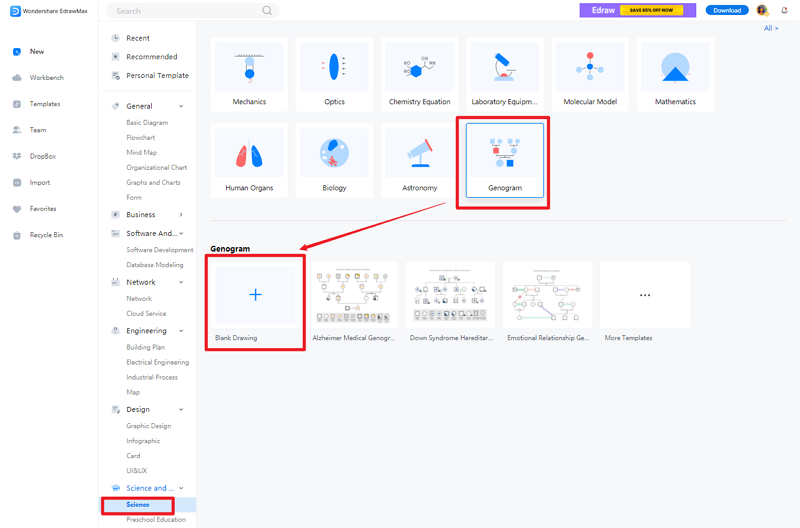
Now, in the template, you need to customize it as you want it to be. You can select the shape library and drag and drop different shape components. You can draw and format connections between these shapes. You can align them, format them, and give them the necessary style. Once the basic ecomap is created, you can use other drawing tools, theme features, color fill, auto theme, and so on to give the map a nice look.
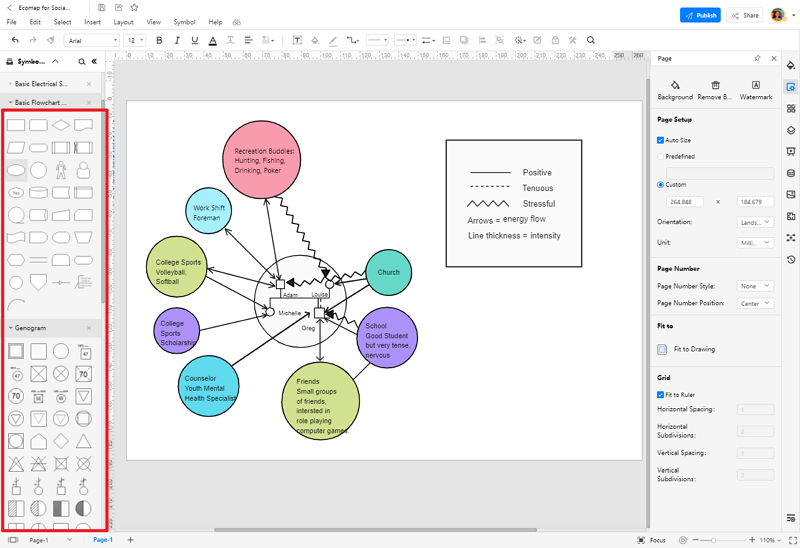
The final step is to save the file, export it, and share it. You need to click on ‘File’ at the top left, which will have ‘Export’. You will find there a number of formats in which you can export the ecomap. Once it is exported, you can share it accordingly.
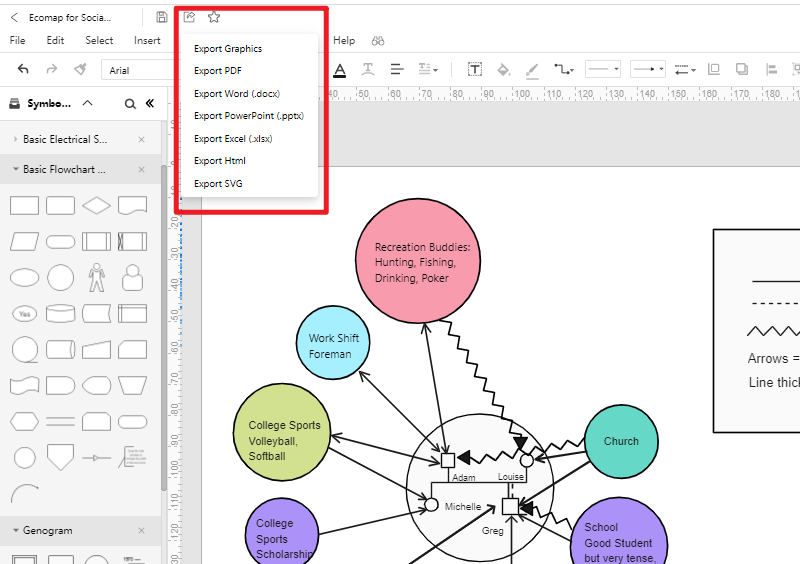
5. Useful Ecomap Templates [Free Editable]
Ecomaps help professionals assess their client’s connection with the surrounding. It tells about not only the connection but also the quality of those connections. The type of ecomap varies based on the need. That is why if you know enough about different ecomap examples, it will help you create one efficiently. Here are some ecomap examples.
Example 1: Family Ecomap
Family ecomaps are the most common type of all. These graphical presentations help professionals assess connections at play in a family and surrounding them, and the quality of these relationships. Family ecomaps can be either concise or massive, based on what areas the interviewer is willing to cover. However, some common connections included in a family ecomap are schooling, friends and extended family, religious connections, sports activities, and so on.
Example 2: Social Work Ecomap
Social work ecomaps tell about an individual and the connections he has in his social boundary. The common information of the individual placed at the center of the ecomap includes his or her name, age, and current living. The common connections built with the individual in such social work ecomaps include social agencies, work supervisors, training programs, peers, teachers, sports activities, teams, clubs, and so on. Some family members, like siblings, parents, and other members, may also be included.
Example 3: Example of Ecomap
A simple example of ecomap centers an individual regarding whom the interviewer wants to assess connections with others. Then, the name of the people and their designation is put around that individual in the ecomap. Common among these people are the family members, which include siblings, parents, sometimes cousins, and so on. Besides family members, close connections, including best friends, therapists, religious places the individual goes to, mentors, etc., are also included in the ecomap.
6. FAQs About Ecomap
What’s the difference between ecomap and genogram?
Both genograms and ecomaps are visualization tools. However, they have their differences. A genogram provides information about a family tree that includes the medical history, relational intimacy, mental health history and so on. By studying a genogram, one can understand the familial patterns, both hereditary and pervasive. On the other hand, ecomaps are simpler than genograms, and they speak about the connections of the individual in question with his surroundings.
What is an ecomap in nursing?
One of the common sectors that ecomaps are used in is nursing. In medical science, it is important that the assessments are accurate or as close to accurate as possible. That is why nurses create ecomaps to have the proper information about the patient. It helps them identify the problems and plan the interventions accordingly. It also gives the nurses direction towards identifying the strength of the existing gaps so that it gets easy to fill them in.
What are some tips for interviewing for ecomap?
Like all interviews, there are some common tips when it comes to interviews for ecomaps. Some of the dos’s that you can follow are making eye contact, being an active listener to the interviewee, showing interest, being sensitive to the individual’s family’s responses, asking open-ended questions, watching the body language, etc. Some of the things you shouldn’t do while interviewing for ecomaps are looking at the ecomap the entire time, missing the family’s talk, judging the responses of both the interviewee and the family, assuming something by yourself.
7. Key Takeaways
Creating an ecomap may not seem that challenging. However, if you are to create an effective ecomap, you must use tools that provide you with all the elements you need to create one. EdrawMax Online is such a tool, which will help you in many ways to create the ecomap that will benefit you.
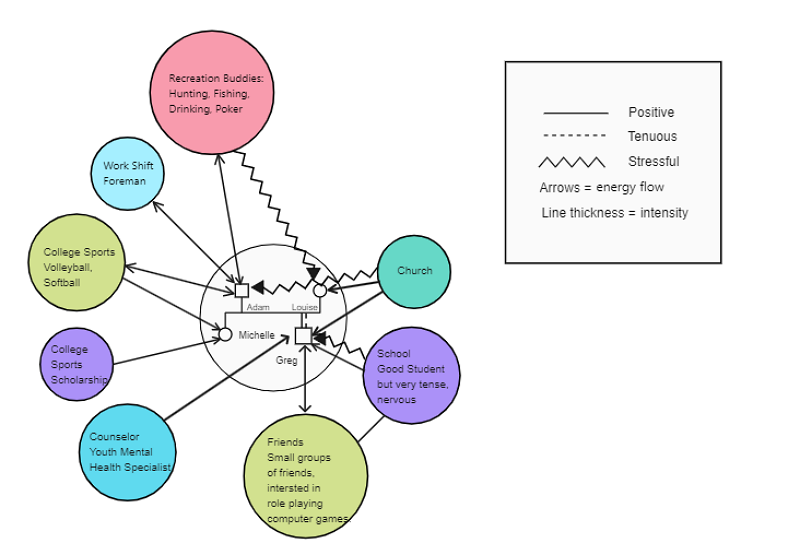
 below.
below.  below.
below. 